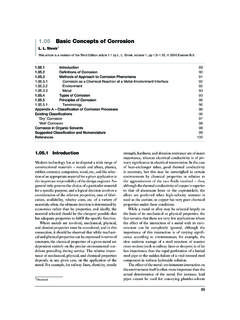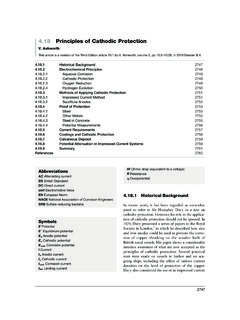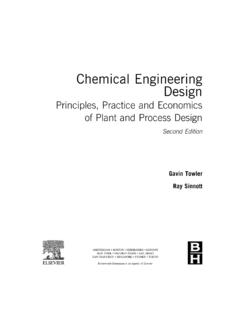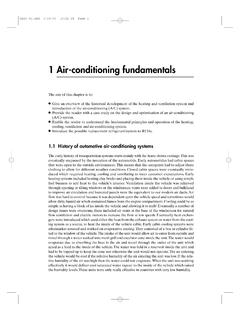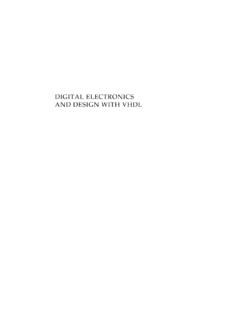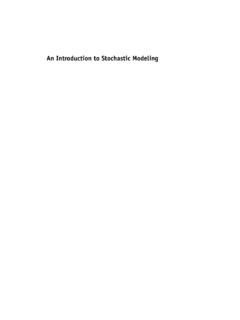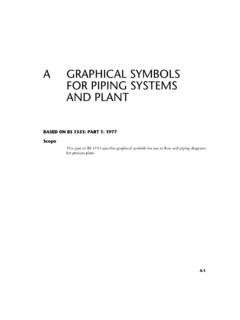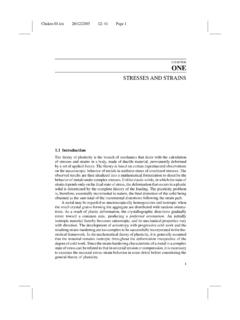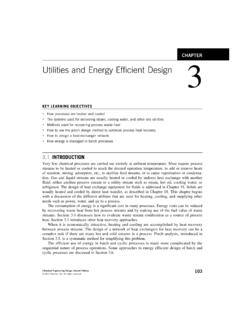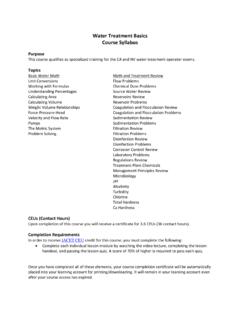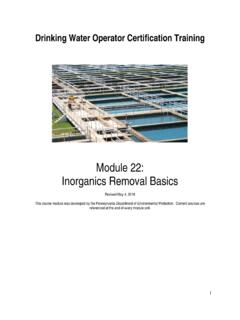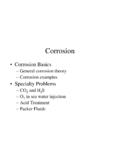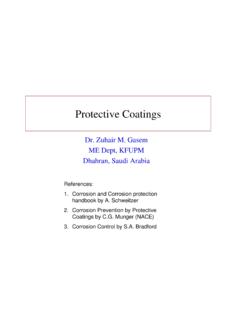Transcription of Introduction to Corrosion - Elsevier
1 Typeset by:CEPHA Imaging Pvt. Ltd., INDIA[16:01 2006/5/18 ]ISBN: 0750659246 AHMAD: Business Research ProjectsPage: 1 1 8 Chapter1 Introduction HistoricalBackground Lay not up for yourselves treasures upon earth wheremoth and rust doth corrupt and where thieves break-through and steal. (Mathew 6:14)The word Corrosion is as old as the earth,but it has been known by different is known commonly as rust, an unde-sirable phenomena which destroys the luster andbeauty of objects and shortens their life. A Romanphilosopher, Pliny (AD 23 79) wrote about thedestruction of iron in his essay Ferrum Cor-rumpitar.
2 Corrosion since ancient times hasaffected not only the quality of daily lives ofpeople, but also their technical progress. Thereis a historical record of observation of corrosionby several writers, philosophers and scientists, butthere was little curiosity regarding the causes andmechanism of Corrosion until Robert Boyle wrotehis Mechanical Origin of Corrosiveness. Philosophers, writers and scientists observedcorrosion and mentioned it in their writings: Pliny the elder (AD 23 79) wrote aboutspoiled iron. Herodotus (fifth century BC) suggested theuse of tin for protection of iron.
3 Lomonosov (1743 1756). Austin (1788) noticed that neutral waterbecomes alkaline when it acts on iron. Thenard (1819) suggested that Corrosion is anelectrochemical phenomenon. Hall (1829) established that iron does not rustin the absence of oxygen. Davy (1824) proposed a method for sacrificialprotection of iron by zinc. De la Rive (1830) suggested the existence ofmicrocells on the surface of most important contributions were latermade by Faraday (1791 1867) [1] who estab-lished a quantitative relationship between chem-ical action and electric current.
4 Faraday s firstand second laws are the basis for calculation ofcorrosion rates of metals. Ideas on corrosioncontrol started to be generated at the begin-ning of nineteenth century. Whitney (1903)provided a scientific basis for Corrosion controlbased on electrochemical observation. As earlyas in eighteenth century it was observed thatiron corrodes rapidly in dilute nitric acid butremains unattacked in concentrated nitric nbein in 1836 showed that iron could bemade passive [2]. It was left to U. R. Evans to pro-vide a modern understanding of the causes andcontrol of Corrosion based on his classical electro-chemical theory in 1923.
5 Considerable progresstowards the modern understanding of corrosionwas made by the contributions of Evans [3],Uhlig [4] and Fontana [5]. The above pioneersof modern Corrosion have been identified withtheir well known books in the references givenat the end of the chapter. Corrosion laboratoriesTypeset by:CEPHA Imaging Pvt. Ltd., INDIA[16:01 2006/5/18 ]ISBN: 0750659246 AHMAD: Business Research ProjectsPage: 2 1 82 Principles of Corrosion Engineering and Corrosion Controlestablished in , USA and University ofCambridge, UK, contributed significantly to thegrowth and development of Corrosion scienceand technology as a multi disciplinary recent years, Corrosion science and engineer-ing has become an integral part of engineeringeducation DefinitionsCorrosion is a natural and costly process ofdestruction like earthquakes, tornados, floodsand volcanic eruptions, with one major differ-ence.
6 Whereas we can be only a silent spectator tothe above processes of destruction, Corrosion canbe prevented or at least controlled. Several defi-nitions of Corrosion have been given and some ofthem are reproduced below:(A) Corrosion is the surface wastage that occurswhen metals are exposed to reactive envi-ronments.(B) Corrosion is the result of interactionbetween a metal and environments whichresults in its gradual cycle(C) Corrosion is an aspect of the decay ofmaterials by chemical or biological agents.(D) Corrosion is an extractive metallurgy inreverse.
7 For instance, iron is made fromhematite by heating with carbon. Iron cor-rodes and reverts to rust, thus completingits life cycle. The hematite and rust have thesame composition (Fig. ).(E) Corrosion is the deterioration of materialsas a result of reaction with its environment(Fontana).(F) Corrosion is the destructive attack of a metalby chemical or electrochemical reaction withthe environment (Uhlig).Despite different definitions, it can beobserved that Corrosion is basically the result ofinteraction between materials and their environ-ment.
8 Up to the 1960s, the term Corrosion wasrestricted only to metals and their alloys and it didnot incorporate ceramics, polymers, compositesand semiconductors in its regime. The term cor-rosion now encompasses all types of natural andman-made materials including biomaterials andnanomaterials, and it is not confined to metalsand alloys alone. The scope of Corrosion is consis-tent with the revolutionary changes in materialsdevelopment witnessed in recent by:CEPHA Imaging Pvt. Ltd., INDIA[16:01 2006/5/18 ]ISBN: 0750659246 AHMAD: Business Research ProjectsPage: 3 1 8 Introduction to CorrosiveEnvironmentCorrosion cannot be defined without a referenceto environment.
9 All environments are corrosiveto some degree. Following is the list of typicalcorrosive environments:(1) Air and humidity.(2) Fresh, distilled, salt and marine water.(3) Natural, urban, marine and industrialatmospheres.(4) Steam and gases, like chlorine.(5) Ammonia.(6) Hydrogen sulfide.(7) Sulfur dioxide and oxides of nitrogen.(8) Fuel gases.(9) Acids.(10) Alkalies.(11) may, therefore, be observed that corrosionis a potent force which destroys economy, depletesresources and causes costly and untimely failuresof plants, equipment and Consequences ofCorrosionSome important consequences of Corrosion aresummarized below: Plant shutdowns.
10 Shutdown of nuclearplants, process plants, power plants andrefineries may cause severe problems toindustry and consumers. Loss of products, leaking containers, storagetanks, water and oil transportation lines andfuel tanks cause significant loss of product andmay generate severe accidents and is well known that at least 25% of water islost by leakage. Loss of of heatexchanger tubings and pipelines by corrosionproducts reduces heat transfer and pipingcapacity. Contamination. Corrosion products maycontaminate chemicals, pharmaceuticals, dyes,packaged goods, etc.
